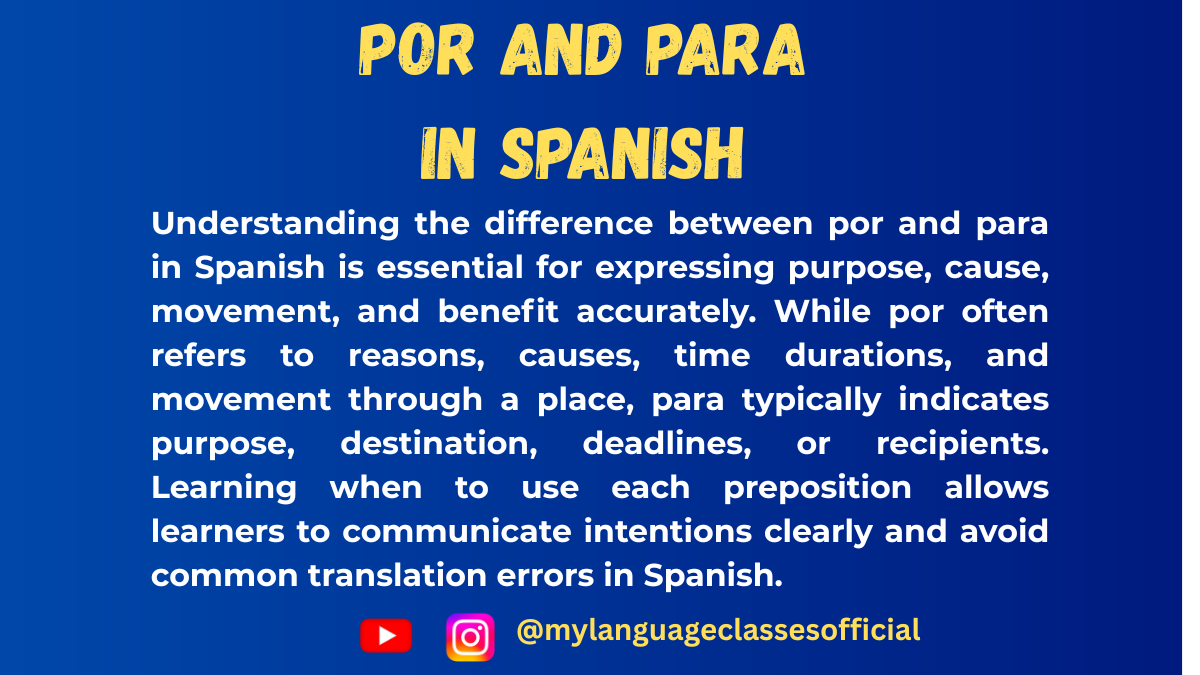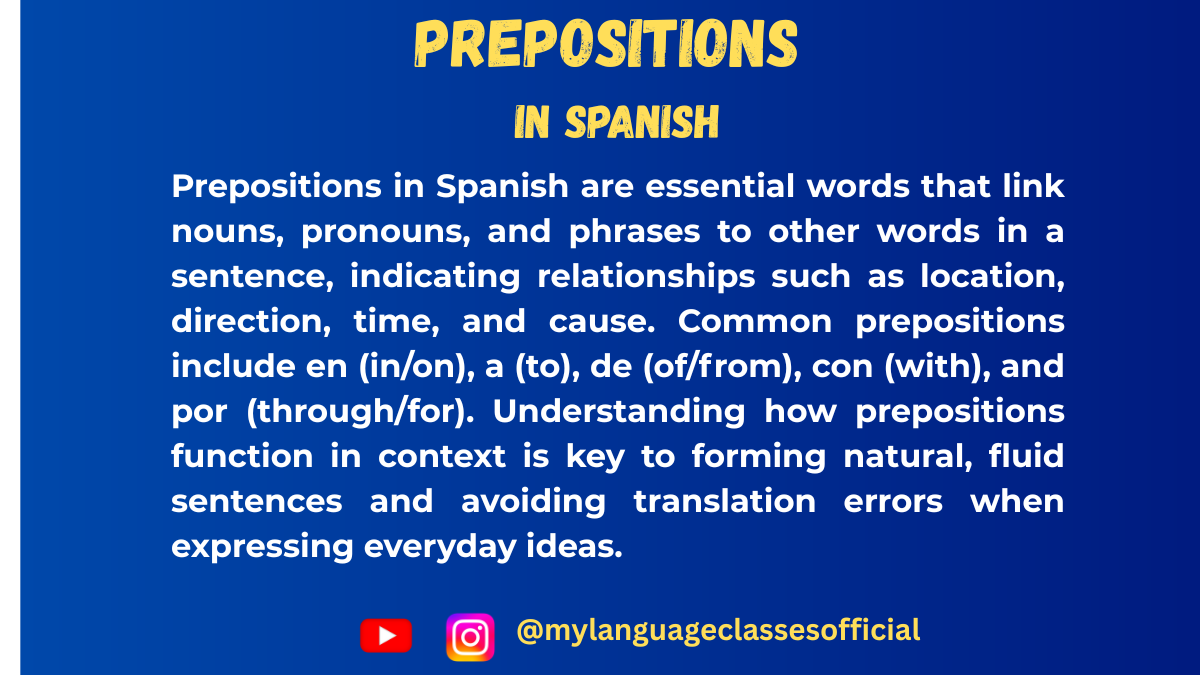Your cart is currently empty!
Tag: por vs para
-

Everything You Need to Know About POR in Spanish
One of the most challenging aspects of learning Spanish is understanding the difference between por and para. Both words can be translated as “for,” but they are used in different contexts. In this blog post, we will focus entirely on por, explaining its various uses, common expressions, grammatical considerations, and examples to help you master it like a native speaker.
Main Uses of POR in Spanish
The preposition por is used in multiple contexts in Spanish. Below is a breakdown of its main uses along with example sentences.
Usage Explanation Example Sentence Cause or Reason Used to explain the reason behind an action (similar to “because of”). Me castigaron por llegar tarde. (They punished me for arriving late.) Duration of Time Used to express how long something lasts. Estudié español por tres años. (I studied Spanish for three years.) Exchange or Substitution Used when something is exchanged or substituted. Te doy mi libro por tu cuaderno. (I’ll give you my book for your notebook.) Means of Communication or Transportation Used to indicate how something is done. Hablamos por teléfono. (We spoke on the phone.) / Viajé por tren. (I traveled by train.) Movement Through a Place Used when referring to motion through or around a place. Caminamos por el parque. (We walked through the park.) General Location Used to indicate an approximate location. Vive por aquí. (He/She lives around here.) Agent in Passive Voice Used to indicate who performed an action in the passive voice. El libro fue escrito por Gabriel García Márquez. (The book was written by Gabriel García Márquez.) Multiplication or Measurement Used in mathematics or measurements. Cinco por cinco es veinticinco. (Five times five is twenty-five.) Motive or Reason for an Action (on behalf of someone) Used when doing something for someone else. Lo hice por ti. (I did it for you.) Gratitude or Apology Used to express thanks or apologies. Gracias por tu ayuda. (Thanks for your help.) Emotion Towards Someone or Something Used to express feelings. Tengo mucho respeto por mis profesores. (I have a lot of respect for my teachers.)
Common Expressions with POR
Many fixed expressions in Spanish include por. Here is a list of some of the most common ones, their meanings, and example sentences.
Expression Meaning Example Sentence Por favor Please Por favor, dime la verdad. (Please, tell me the truth.) Por supuesto Of course Por supuesto que te ayudaré. (Of course, I will help you.) Por fin Finally Por fin llegaron las vacaciones. (Finally, the holidays arrived.) Por lo menos At least Necesito dormir por lo menos ocho horas. (I need to sleep at least eight hours.) Por ejemplo For example Me gustan los deportes, por ejemplo, el fútbol. (I like sports, for example, soccer.) Por ahora For now No tengo trabajo, por ahora. (I don’t have a job, for now.) Por si acaso Just in case Lleva un paraguas, por si acaso llueve. (Take an umbrella, just in case it rains.) Por desgracia Unfortunately Por desgracia, no puedo ir a la fiesta. (Unfortunately, I can’t go to the party.) Por todos lados Everywhere Hay turistas por todos lados. (There are tourists everywhere.) Por eso That’s why Está lloviendo, por eso llevamos paraguas. (It’s raining, that’s why we’re carrying umbrellas.) Por mi parte As for me Por mi parte, prefiero quedarme en casa. (As for me, I prefer to stay home.)
Things to Keep in Mind When Using POR
1. Gender and Number Agreement
- Por itself does not change for gender or number, but the articles and adjectives surrounding it must agree with the noun.
- Example: Caminamos por el bosque. (We walked through the forest.)
- Example: Pasamos por la plaza. (We passed through the square.)
2. When Not to Use POR
- Many learners confuse por and para. If you are referring to a destination, purpose, or deadline, use para instead of por.
- Correct: Este regalo es para ti. (This gift is for you.)
- Incorrect: Este regalo es por ti.
3. Using POR in Questions
- Por qué = Why? (Used in questions.)
- Example: ¿Por qué estudias español? (Why do you study Spanish?)
- Porque = Because (Used in answers.)
- Example: Estudio español porque me gusta. (I study Spanish because I like it.)
Conclusion
Mastering por is essential for fluency in Spanish. It appears in many everyday expressions, grammatical structures, and idiomatic phrases. By understanding its various meanings and practicing its usage, you will be able to speak Spanish more naturally. Keep an eye on key differences between por and para, and remember the most common expressions with por to improve your conversational skills!
If you enjoyed this lesson, be sure to check out more posts like this on my blog at My Language Classes. Don’t forget to subscribe my YouTube channel and follow me on Instagram for the latest language learning tips and lessons. Leave a comment below to share your thoughts, or ask any questions you have.
Happy learning! 😊
- Por itself does not change for gender or number, but the articles and adjectives surrounding it must agree with the noun.
-

Mastering Por and Para in Spanish
One of the trickiest aspects of learning Spanish is understanding the difference between por and para. While they both translate to “for” in English, their meanings and applications differ significantly depending on the context. In this blog post, we’ll dive into their uses, provide practice questions, share tips for mastery, and conclude with insights to deepen your understanding.
The Basics of Por and Para
- Por: Often indicates cause, means, movement, or duration. Think of it as looking back at reasons or processes.
- Para: Focuses on purpose, destination, or goal. It looks forward to outcomes or effects.
Detailed Uses of Por
- Cause or Reason:
Indicates why something happens.- Por qué llegaste tarde? (Why were you late?)
- Llegué tarde por el tráfico. (I was late because of traffic.)
- Movement Through or Around:
Describes movement in a non-finalized way.- Caminamos por el parque. (We walked through the park.)
- Viajaron por Europa. (They traveled around Europe.)
- Means or Method:
Explains how something happens.- Te llamé por teléfono. (I called you by phone.)
- Mandé el paquete por correo. (I sent the package by mail.)
- Duration or Frequency:
Refers to how long or how often something occurs.- Estudié por tres horas. (I studied for three hours.)
- Voy al gimnasio dos veces por semana. (I go to the gym twice a week.)
- Exchange or Substitution:
Describes a trade or replacement.- Pagué veinte dólares por este libro. (I paid twenty dollars for this book.)
- Cambié mi auto viejo por uno nuevo. (I exchanged my old car for a new one.)
- Expressions of Emotion:
Highlights the cause of a feeling.- Tengo mucho respeto por ti. (I have a lot of respect for you.)
- Lo hizo por amor. (He did it out of love.)
- Idiomatic Expressions:
Learn these as set phrases:- Por favor (Please)
- Por supuesto (Of course)
- Por fin (Finally)
Detailed Uses of Para
- Purpose or Goal:
Focuses on the reason behind an action.- Estudio para ser doctor. (I study to become a doctor.)
- Trabajo para mejorar mi vida. (I work to improve my life.)
- Recipient:
Describes who benefits from an action.- Este regalo es para ti. (This gift is for you.)
- Hice este dibujo para mi mamá. (I made this drawing for my mom.)
- Deadlines:
Indicates time limits or expectations.- El proyecto es para mañana. (The project is due tomorrow.)
- Tenemos que estar listos para las 8. (We need to be ready by 8.)
- Destination:
Specifies where something is going.- Vamos para la playa. (We’re heading to the beach.)
- Salgo para Madrid esta noche. (I leave for Madrid tonight.)
- Opinion:
Used to express perspectives or preferences.- Para mí, es una buena idea. (In my opinion, it’s a good idea.)
- Para él, la tarea es difícil. (For him, the homework is hard.)
- Comparison to Standard:
Highlights unusual or unexpected qualities.- Para su edad, es muy madura. (For her age, she is very mature.)
- Para ser lunes, estoy de buen humor. (For a Monday, I’m in a good mood.)
Por vs. Para: Key Differences
- Time:
- Use por for duration (por tres horas – for three hours).
- Use para for deadlines (para mañana – for tomorrow).
- Movement:
- Use por for movement through a place (por el túnel – through the tunnel).
- Use para for destinations (para el hotel – to the hotel).
- Reason vs. Goal:
- Use por for reasons (por el mal tiempo – because of bad weather).
- Use para for goals (para aprender – to learn).
Practice Questions
- Translate:
- I bought this for my friend.
- We’ll be in Spain for two weeks.
- This book is for studying.
- They canceled the party because of the rain.
- Choose the correct preposition:
- Salgo ___ la escuela a las 7. (por/para)
- Hice esto ___ ti. (por/para)
- Gracias ___ venir. (por/para)
- Identify the context of por or para:
- ¿Por qué lo hiciste?
- Estudio para mejorar mi español.
Tips for Mastering Por and Para
- Think Cause vs. Purpose:
- Use por for reasons (past or present causes).
- Use para for goals or effects (future intentions).
- Visualize the Destination:
- Use para when thinking about a final result or destination.
- Memorize Idioms:
- Learn common expressions like por favor and para siempre.
- Practice in Context:
- Try to create sentences using both words to compare their meanings.
- Take Note of Patterns:
- Some verbs are almost always paired with por or para (e.g., gracias por, trabajar para).
Final Thoughts and Conclusion
Understanding the difference between por and para can feel challenging at first, but with practice, the nuances become clearer. Think of por as reflecting reasons, processes, or exchanges, while para points toward goals, outcomes, and destinations. By focusing on their key differences and practicing regularly, you’ll gain confidence in distinguishing them.
Both por and para are indispensable in Spanish, and mastering them will elevate your fluency. Use the practice questions, keep experimenting with sentences, and don’t shy away from making mistakes—learning a language is a journey of trial and discovery.
¡Buena suerte! (Good luck!)
If you enjoyed this lesson, be sure to check out more posts like this on my blog at My Language Classes. Don’t forget to subscribe my YouTube channel and follow me on Instagram for the latest language learning tips and lessons. Leave a comment below to share your thoughts, or ask any questions you have.
Happy learning! 😊



